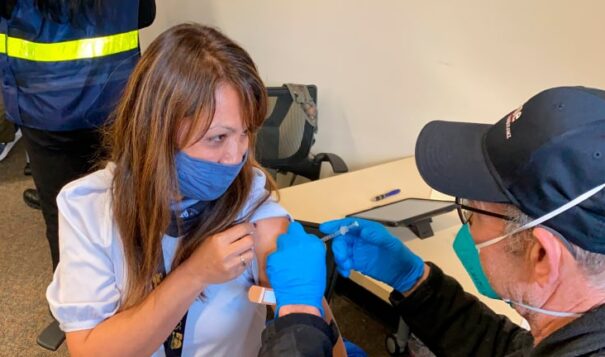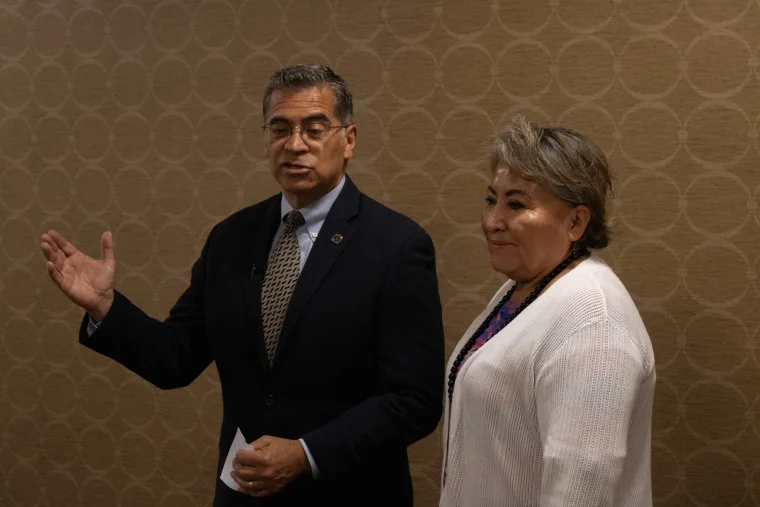News Based on facts, either observed and verified directly by the reporter, or reported and verified from knowledgeable sources.
Looking ahead on COVID-19 vaccines in Native communities
 In this Feb. 19, 2021, file photo, Grace John, who works at a school in San Lorenzo, gets a COVID-19 shot at a mobile vaccination clinic run by the Federal Emergency Management Agency and the state in Hayward, California. (AP Photo/Terry Chea, File)
In this Feb. 19, 2021, file photo, Grace John, who works at a school in San Lorenzo, gets a COVID-19 shot at a mobile vaccination clinic run by the Federal Emergency Management Agency and the state in Hayward, California. (AP Photo/Terry Chea, File)
It’s also the first fall and winter virus season where vaccines are available for the three viruses responsible for most hospitalizations – COVID-19, RSV and flu
Here comes another round of COVID-19 vaccines.
The Food and Drug Administration approved and authorized the updated Pfizer-BioNTech and Moderna mRNA COVID-19 vaccines for this fall and winter. Everyone six months and older, regardless of current vaccination status, are recommended to get vaccinated.
“…this booster is the best guessed replica of the COVID-19 variant that will be circulating out in the fall,” Dean Seneca, CEO of Seneca Scientific Solutions and former director of the Great Lakes Inter-Tribal Epidemiology Center, said.
He said as the COVID-19 virus mutates more vaccines will be needed to combat those specific variants, and it’s concerning how the current COVID-19 variant, BA.2.86, has more than 30 mutations compared to the average flu virus that has an average of six or eight mutations.
The new COVID-19 variant shows it’s becoming stronger and more transmittable.
Seneca said it’s important especially for Native communities to receive the booster because of preexisting conditions such as high diabetes rates, cancer rates and substance abuse disorders. Other factors that are included are multiple families living in a single household and lack of easy access to healthcare facilities.
He recommends tribes and tribal organizations to encourage citizens to vaccinate by doing more outreach, education and raising awareness. Some examples could be to send mobile units to administer vaccines for people who travel far distances for healthcare and to first start with elders by doing raffles or free bingo nights.
“If we’re able to vaccinate our elders, our elders will tell their kids who are tribal leaders, in many cases, what to do and hopefully they will listen,” Seneca said.
It’s also the first fall and winter virus season where vaccines are available for the three viruses responsible for most hospitalizations – COVID-19, RSV (Respiratory Syncytial Virus) and flu.
Seneca anticipates seeing more flu and RSV cases in the fall as well.
Indian Country continues to educate
The National Council of Urban Indian Health is conducting an event called “Paths to Vaccine Equity: Vaccine Toolkits and Educational Materials” on Oct. 12. Tiffani Stark, public health manager for the council, Myca Grant Hunthrop, public health project coordinator for the council, and Nicole Richardson-Smith, CDC Influenza Division, will be presenting.
The community of learning series will share “best practices and resources for clinicians addressing annual vaccinations, vaccine awareness, and providing education to encourage vaccinations among urban American Indian/Alaska Native patients,” according to their website.
The National Indian Health Board also advised people to vaccinate.
“It’s been a while since you’ve heard this from us, but COVID-19 cases are on the rise again! With back-to-school season rapidly approaching, it’s more important than ever that we try to stop the spread. Don’t forget – it’s easy to show your community an #ActOfLove! Make sure to wear a mask or stay home if you’re not feeling well, wash your hands often with soap and water, or use hand sanitizer, and get your COVID-19 vaccine or booster if you haven’t!” the board posted on Facebook.
The Indian Health Service released an update on Monday, Sept. 18 that included the approval of the updated COVID-19 vaccines.
It stated more information will be coming as it prepares for vaccine distribution across the Indian health system.
“Many IHS facilities are coordinating and synchronizing fall vaccine efforts, so that all vaccine needs can be met at the same visit. All vaccines, including for COVID-19, influenza, respiratory syncytial virus, and other routine vaccines, may be administered at the same visit,” IHS Director Roselyn Tso said in a statement issued Friday, Sept. 22..
“Vaccination remains the best protection against COVID-19-related hospitalization and death,” she added. “The virus that causes COVID-19 is always changing, and protection from COVID-19 vaccines declines over time. Receiving an updated mRNA COVID-19 vaccine can help provide protection against the variants currently responsible for most infections and hospitalizations”
IHS Chief Medical Officer Loretta Christensen, Navajo, said on the ICT Newscast with Aliyah Chavez on Sept. 14 that “it’s a very complicated process that they’re completely prepared for.”
“We have all our methods, we’ve been giving education on the rollout of the new vaccine, when they become available. We just have to basically plug it in our new system and get the supply chain moving,” she said.
She also advises to practice good hand washing hygiene, wear a mask when in an enclosed space or if you’re coughing.
The vaccine administered by IHS will be at no cost.

However, not all are so fortunate.
Some people seeking the newest COVID-19 vaccine are running into high demand, insurance headaches and supply delays coast to coast, according to the Associated Press.
Millions of the newly formulated vaccines have shipped out since the Centers for Disease Control and Prevention signed off. But some people have had to cancel appointments because their insurance hasn’t updated the billing codes to cover the vaccines. Others signed up for an appointment, only to have it canceled due to supply issues. And in some places, there are no available nearby vaccines: A search in Juneau, Alaska, through the federal government’s website shows no available appointments within 100 miles.
Meanwhile, the Biden administration is restarting a website allowing Americans to again order up to four free tests per household — aiming to prevent possible shortages during a rise in coronavirus cases that has typically come during colder months.
The Department of Health and Human Services says orders can be placed at COVIDTests.gov starting Monday, Sept. 25, and that no-cost tests will be delivered for free by the United States Postal Service.
Dawn O’Connell, assistant secretary for preparedness and response at HHS, said that though some portions of the public may be tired of the pandemic and its implications, at home-testing remains a key way to slow the spread of new cases.
“Whether or not people are done with it, we know the virus is there, we know that it’s circulating. We know, if the past is prologue, it’ll circulate to a higher degree and spread, and cases will go up in the fall and winter seasons,” O’Connell said. “Anticipating that that would be true again, or something similar, we want to make sure the American people have these tools.”
The Associated Press contributed to this report.
